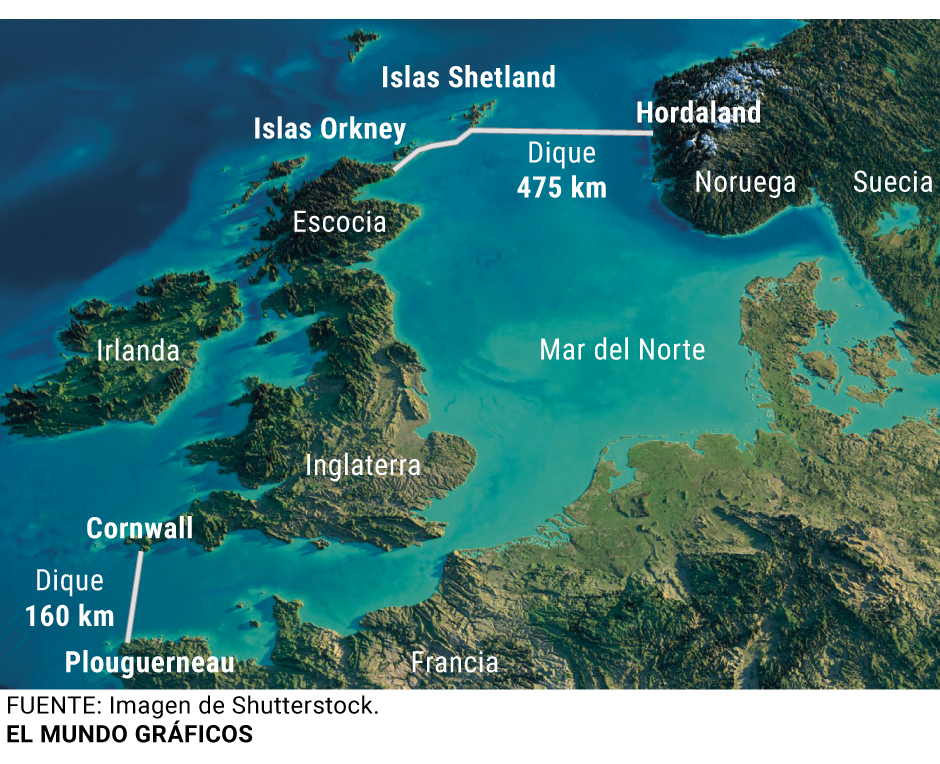- Torrential rains. Climate change has changed the pattern of floods in Europe
- Climate crisis: Coastal flooding will affect 210,000 Spaniards in 2050
Two imposing dams to the Dutch to "close" the North Sea. Two gigantic structures - 475 and 160 kilometers long, respectively - to protect some 25 million Europeans from rising sea levels and flooding. It is the proposal of oceanographers Sjoerd Groeskamp and Joakim Kjellsson, which have just been detailed in the American Journal of Meteorology .
"It is an expensive solution, but technically possible," the authors warned in unison. "Although the design of such an extreme dike should serve us primarily as an alarm signal: a way to reveal the immensity of the problem we have on our heads."
Sjoerd Groeskamp, who works for the Royal Netherlands Institute of Sea Research, claims to have put in the megaproject of the North Sea all the experience accumulated during the last century in the Netherlands. And especially the construction of the Afsluitdijk dike (32 kilometers long) and the great Oosterschelde dike, the two superstructures that allow almost a third of the Dutch to live below sea level.
A complex system of dikes, pumping stations, canals and natural barriers has kept the Netherlands "afloat" for decades. The protections have served to keep the North Sea at bay, despite the increase of 21 centimeters in sea level since the pre-industrial era. Scientists warn, however, that the rise could be 30 to 60 centimeters throughout the 21st century, with the current projection of CO2 emissions.
"The predictions speak of an increase of 10 meters of the sea level in the year 2500, in accordance with the most demanding scenarios", warns the oceanographer Sjoerd Groeskamp. " Superdikes are a way to remind us that we must act against climate change now . If we do nothing, they will eventually be the last solution."
"If they get to be built, we would surely be facing the greatest engineering work on the planet, " warn the authors of the proposal, who also put the Saemangeum dike in South Korea as a reference, which extends over 45 kilometers with a depth of 36 meters.
The authors emphasize how the low depth of the North Sea (127 meters on average between Scotland and Norway, and 100 meters between England and France) make the idea more feasible. "Today, fixed platforms are being built at depths that exceed 500 meters," they warn.
The shortest dam, 160 kilometers long, would close the North Sea in the south, between the coasts of Cornwall and Brittany. The authors argue that this structure could even serve as a "bridge" for road traffic between England and France.
More complex would undoubtedly be the northern dike, between Scotland and Norway, passing through the Orkney and Shetland Islands. Of the 475 kilometers, 331 would be in the open sea. Before reaching the shores of Norway, the seabed also reaches a maximum depth of 320 meters that would further complicate the works.
Extrapolating the cost of the South Korean superdike, Sjoerd Groeskamp and Joakim Kjellsson estimate that the construction of the two superdikes could be between 250,000 million and 500,000 million euros. Spread over 20 years, the cost would be around 0.1% of the annual GDP of the 14 countries that would benefit from the project. Among them, Belgium, the Netherlands, Germany, Denmark or France, identified by a recent report by the European Environmental Agency as being at high risk due to the rise in the North Sea level.
The authors recognize, however, that the two dikes would not have a great ecological impact on marine fauna , tidal regulation, fishing and navigation in the North Sea, and estimate that up to 100 stations would be needed. of pumping to lower the salinity of the waters.
"The only alternative is to avoid rising sea levels, implementing climate change mitigation measures and immediately reducing carbon dioxide emissions," the authors conclude.
Four dead at Dennis Pass
The passage of the Dennis storm - the second storm to hit the British coast in just one week - has caused at least four deaths, has flooded at least 400 homes and has wreaked havoc in Wales and parts of northern and southern England, that they registered in two days the equivalent to the rains of a whole year. More than 400 cars were rescued in the flooded areas.
The strong winds and rained rains forced to partially suspend the rail service in much of the country and cancel a hundred flights at Heathrow airport, severely also affected last week by the Ciara storm.
The attitude of the 'premier' Boris Johnson, who spends a few days of business in Chevening and will move to the affected areas, has caused in the meantime the fury of the political class due to the inadequacy of the defenses against floods and the lack of action before climate change.
The Secretary of the Environment, Gerge Eustice, has stated, however, that the infrastructure to prevent the floods erected in the last decade has prevented the evacuation of at least 20,000 threatened homes. Eustice reiterated the Johnson Government's plan to invest the equivalent of 5,000 million euros in the construction of natural barriers in areas most threatened by floods.
According to the criteria of The Trust Project
Know more- science
- Science and Health
- Graphics
Graphic Report Australia, zone zero of climate change
Graphic report Australia: zero zone of climate change
In Australia The impact of the oldest known asteroid altered the weather 2,229 million years ago

